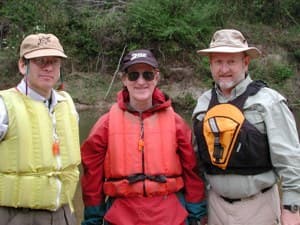How to Pick a PFD
In the 1960's and 70's I was hooked on whitewater canoeing. When I moved to Minnesota in 1977, I joined the Minnesota Canoe Association and a sub-club called the "Rapid Riders". In those days, we mostly paddled 17-foot Grumman's with shoe-keels, though there were some fiberglass C1's and C-2's. I especially loved the C1's which, in those days, had a simple bench seat (no foam pedestals then), knee pads and thigh straps, and compared to the Grumman's, they turned on a dime. The most recommended life jacket was the French made Flotherchoc-a trim, tubular style vest which looked a bit like an accordion. Flotation was provided by air-filled plastic tubes which were sewn inside the nylon shell. The International Canoe Federation required just 13 pounds of flotation, and the Flotherchoc was right on target. This vest was so comfortable you could barely detect its presence.

I lusted for one of these French jackets, but the cost (about 40 dollars in those days) was beyond my means. I settled instead for a then new, Stearns panel vest, which was much less cool looking and far less comfortable. But it did have a bit more flotation and, unalike the Harishok, the foam panels would not lose buoyancy over time.
PFD's have improved significantly since the 1970's. But comfort-wise, I mourn the passing of the old tubular-style models. The many broken tubes of those old vests followed every contour of your body. They clung less tightly than modern vests and so they were cool to wear in July heat. And the narrow tubes were unobtrusive-you felt like you were wearing a light down vest instead of a PFD. Admittedly, they weren't as buoyant as the new models. But they were reliable on lakes and in the Class I-III rapids most people paddle.
The beauty of the old tubular vests is that they were cool and comfortable enough to wear all the time. Maybe I'm just built wrong, but I have yet to find a new high-tech vest that feels as good on my body as my ancient British Harishok.
COMFORT FIRST!
A comfortable fit is everything! How the vest feels on your body is every bit as important as its performance in water. For these reasons, it's best not to buy a personal flotation device (PFD) by mail. Sizing, cut, flexibility and utility vary widely from manufacturer to manufacturer. Here's how to test the fit of a PFD that catches your fancy.
Ride up:
Grasp the jacket by the shoulders and lift it upwards until the fabric jams under your armpits. This simulates performance in water. Now turn your head right and left. You should be looking over your shoulder not at fabric encased foam. Does the V-neck of the vest crunch against your chin? If so, keep shopping. PFD'S which force the chin up may have a more positive righting moment than do those which don't, but they hinder maneuverability in water--exactly what you don't want when you have to swim a rapid!
Buoyancy:
Standard procedure for floating rapids is to get on your back, feet held high to prevent somersaulting in the current. Use your feet and paddle to ward off rocks and try to backferry yourself to shore. In this attitude, the flotation foam on your chest is worthless. Back floatation is everything. So reject any PFD that has a skimpy or skeleton foam back.
Arm function:
Take a seat. This test won't work while standing or kneeling. Now, work your arms vigorously in a paddling motion. Any vest which chafes under the armpits will be intolerable to wear over the long haul. Short-waisted people (especially women) will have trouble here. If a jacket chafes anywhere, keep shopping!
Flexibility:
Hold your arms chest high and draw them smartly inward as far as possible. Does the vest bunch up in front and cramp arm motion? If so, keep looking!
Breathability:
Give breathability serious thought, more so, if most of your canoeing is in the heat of summer. Yes, a tight-fitting PFD that hugs your body, is safer than a loose-fitting one that will ride up in water. Still, you may have to compromise for the sake of comfort. Ideally, the vest should be easy to loosen for air flow on hot days, yet be quickly tightened when there is rough water ahead. Models that are tough to adjust will probably be worn loose, which can be dangerous if you capsize in a rapid.
Easy on, easy off:
Some of the best whitewater vests are a pain to put on and take off. This is acceptable where safety is the main concern. But if you're wilderness canoeing in the BWCA or Canada, where frequent portages are the rule, you will want an easy on, easy off PFD. For me, that means a conventional vertical zipper at the front.
Color:
Choose a bright color that will contrast against the water. You want to be seen, and fast, if you capsize.
Cliff Jacobson is a professional canoe guide and outfitter for the Science Museum of Minnesota, a wilderness canoeing consultant, and the author of more than a dozen top-selling books on camping and canoeing. www.cliffcanoe.com
Related Articles
In this video, the team at Austin Kayak show you how to rebuild your keel if you have created a hole…
When Alv Elvestad, owner of Pakboats (www.pakboats.com) invited me to join him and three friends on a…
Experienced wilderness canoe trippers know that small errors can cause big problems. In my previous…


